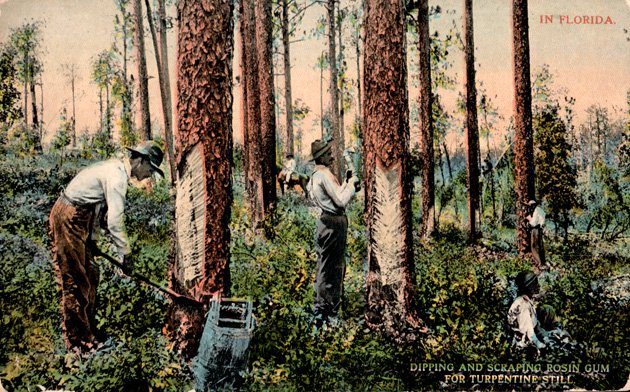
Back of postcard: “A Turpentine Dipper at Work, Florida” (1910) [Alachua County Historic Trust: Matheson History Museum Digital Collections, The University of Florida] (https://ufdc.ufl.edu/MH00000522/00001/images)
Turpentine Postcard
for
Regeneration: Environment, Art, Culture

“Dipping and Scraping Rosin Gum for Turpentine Still in Florida” (1910-20) [Alachua County Historic Trust: Matheson History Museum Digital Collections, The University of Florida] (https://ufdc.ufl.edu/MH00000517/00001/citation)

After 1907, American law required that postcards have a divided back – which allowed for an address and short message – and be mailed at a rate of one cent per, leading to a postcard boom in the early twentieth century. With the development of cheaper, personal cameras and faster postal networks, the postcard industry indexes the changing nature of communication at the turn of the century, where the public circulation of private writing was accompanied by images of nostalgia, labor, and violence (as in lynching postcards). This essay examines a set of postcards from the 1910s and 20s that depict Black labor stripping rosin from pine trees for the production of turpentine in order to theorize the intersections of writing, work, and environment within one of many overlooked histories of extraction in the burgeoning field of the energy humanities.
Largely archaic today, turpentine was an important industrial chemical a century ago, and while the focus of energy studies is most often attentive to oil, gas, and coal, the more invisible, constituent materials of our plastic, modern world depended on other forms of extraction like turpentine farming. In the nineteenth-century, pine forestry took place in what were known as “turpentine orchards,” first in the Carolinas then across the Southern pine forests from Florida to Texas, usually by slave labor. Turpentine was distilled by cutting into the tree and removing the bark. Without the bark, pine trees secrete crude turpentine, or oleoresin, onto the surface of the wound to seal the opening, resist exposure to micro-organisms and insects, and prevent vital sap loss. Harvesters wounded trees in V-shaped streaks down the length of the trunks to channel the crude turpentine into containers. Then it was collected and processed into spirits of turpentine. In a sense, the turpentine is the protective mechanism of the pine, the reaction to being wounded, a kind of tree-“tearing” or “weeping” (in the language of the turpentine farmer).
Mary Kuhn has noted how “the exploitation of the forest was coextensive with the plantation economy,” and these postcards indicate how Black labor was represented “through a pastoral mode that served the planter class by characterizing the work of enslaved people as idyllic.” I argue that these cards condition a reaction to the fronting image in a visual-textual poetics of racial-environmental nostalgia: a forced engagement with the circulation of hidden labor. If narrative presupposes order and sequence, the postcard undermines it, multiplying the sequences of public reading and private writing such that scales of environmental damage are made visible in the everyday distribution of textual economies.